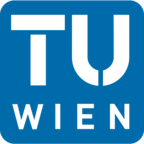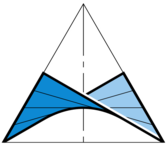|
Events
Conferences, Research Colloquia & Seminars,
Defenses, and other events
|
January 2026
Su Mo Tu We Th Fr Sa
1 2 3
4 5 6 7 8 9 10
11 12 13 14 15 16 17
18 19 20 21 22 23 24
25 26 27 28 29 30 31
|
Geometry Seminar
This is the research seminar of the group and focuses
on recent research in (differential) geometry;
during the semester the seminar is usually scheduled
to take place on Monday at 16:15 in the
Zeichensaal 1
or online.
If you are interested in giving a talk, please contact
the organizers:
Ivan Izmestiev
Student Seminars
These seminars are usually part of the assessment
and are open to the public,
in particular, to interested students;
topics typically focus on geometry but cover a wider range
of areas, depending on the students' and the advisor's
interests.
Presentations are often delivered in German.
|
Summer term 2022 |
Talks in the geometry seminar
(hover/tap name or title to view more information)
- 13 Jun 2022: Geometry seminar (ZS1)
- Jonas Tervooren (TU Wien): Cone-Nets
Abstract
Cone-nets are conjugate nets on a surface such that along each
individual curve of one family of parameter curves there is a
cone in tangential contact with the surface. The corresponding
conjugate curve network is projectively invariant and is
characterized by the existence of particular transformations. We
study properties of the corresponding transformation theory and
illustrate how several known surface classes appear within our
framework. We present cone-nets in a classical smooth setting of
differential geometry as well as in the context of a consistent
discretization with counterparts to all relevant statements and
notions of the smooth setting. Special emphasis deserve smooth
and discrete tractrix surfaces as those cone-nets which are
characterized as principal nets with constant geodesic curvature
along one family of parameter curves.
- 13 Mai 2022 (Fri!) 11:00: Geometry seminar (Dekanatsraum 9th floor)
- Andrew Sageman-Furnas (NC State University):
Constructing isometric tori with the same curvatures
Abstract
Which data determine an immersed surface in Euclidean
three-space up to rigid motion? A generic surface is locally
determined by only a metric and mean curvature function.
However, there are exceptions. These may arise in a family like
the isometric family of vanishing mean curvature surfaces
transforming a catenoid into a helicoid, or as a so-called
Bonnet pair of surfaces.
For compact surfaces, Lawson and Tribuzy proved in 1981 that a
metric and non-constant mean curvature function determine at
most one immersion with genus zero, but at most two compact
immersions (compact Bonnet pairs) for higher genus.
In this talk, we discuss our recent construction of the first
examples of compact Bonnet pairs. It uses a local classification
by Kamberov, Pedit, and Pinkall in terms of isothermic surfaces.
Moreover, we describe how a structure-preserving discrete theory
for isothermic surfaces and Bonnet pairs led to this discovery.
The smooth theory is joint work with Alexander Bobenko and Tim
Hoffmann and the discrete theory is joint work with Tim Hoffmann
and Max Wardetzky.
- 02 May 2022: Geometry seminar (online/zoom)
- Denis Polly (TU Wien): Channel linear Weingarten surfaces in smooth and discrete differential geometry
Abstract
In this talk, we consider linear Weingarten (lW) surfaces in
space forms. These surfaces are defined via a linear relation
between their Gauss and mean curvature. This class of surfaces
contains many important subclasses: minimal surfaces in
Euclidean space, flat fronts in hyperbolic space or, more
generally, surfaces with constant mean or Gauss curvature.
Channel lW surfaces are those lW surfaces that are given as the
envelopes of a 1-parameter family of spheres. Delaunay's
surfaces, constant mean curvature surfaces of revolution, are an
example of this.
Channel lW surfaces have been studied with many different
methods. We will use a Lie sphere geometric setup that allows a
unified treatment of surfaces in different space forms. We aim
for a complete classification of all channel lW surfaces in
terms of transparent and well-behaved parametrisations.
In the realm of discrete differential geometry, circular nets
allow for a notion of face-wise Gauss and mean curvature that is
inspired by Steiner's formula for parallel surfaces. A notion of
discrete channel surfaces as envelopes of a one-parameter family
of Dupin cyclides has recently been developed.
In the discrete portion of the talk, we will investigate
discrete channel lW surfaces and present results that are
similar to the smooth case (with some notable changes). We will
then give an outline for further research that is planned in
this area.
- 04 Apr 2022: Geometry seminar Zoom
- Anna Felikson (Durham): Friezes for a pair of pants
Abstract
Frieze patterns are numerical arrangements that satisfy a local
arithmetic rule. Conway and Coxeter showed that frieze patterns
are tightly connected to triangulated polygons. Recently,
friezes were actively studied in connection to the theory of
cluster algebras, and the notion of a frieze obtained a number
of generalisations. In particular, one can define a frieze
associated with a bordered marked surface endowed with a
decorated hyperbolic metric.
We will review the construction and will show that some nice
properties can be extended to friezes associated to a pair of
pants. This work is joint with Ilke Canakci, Ana Garcia Elsener
and Pavel Tumarkin, arXiv:2111.13135.
- 21 Mar 2022: Geometry seminar Zoom
- Boris Springborn (TU Berlin): The hyperbolic geometry of
Markov's theorem on Diophantine approximation and quadratic forms
Abstract
Markov's theorem classifies the worst approximable irrational
numbers, and the indefinite binary quadratic forms that are
"most nonzero" for integer arguments. This talk is about the
theorem and a new proof using hyperbolic geometry. The main
ingredients are a dictionary to translate between hyperbolic
geometry and algebra/number theory, and some very basic tools
borrowed from modern geometric Teichmüller theory. Simple
closed geodesics and ideal triangulations of the modular torus
play an important role, and so does the problem: How far can a
straight line crossing a triangle stay away from the vertices?
|
Winter term 2021/22 |
Talks in the geometry seminar
(hover/tap name or title to view more information)
15 Dec 2021
postponed to 26 Jan 2022: Geometry seminar - Alexander Glazman (Uni Wien): Phase transitions in two dimensions
Abstract
Phase transitions are natural phenomena when a small change of
external parameter, like temperature, leads to a drastic change
of the properties of the material: ice melting to water,
ferromagnets becoming paramagnets above the Curie temperature,
etc. To study these phenomena, one introduces lattice models -
particles are placed in a lattice and only adjacent particles
interact. In two dimensions, this leads to beautiful conjectures
of universality and conformal invariance, with random fractal
SLE curves appearing in the limit.
The talk aims to describe some of the classical results and the
state of the art in the area now. If time permits, we will also
discuss the main ideas in the proofs.
24 Nov 2021
postponed to 12 Jan 2022 (online): Geometry seminar - Corentin Fierobe-Kozyreva (IST Austria): From billiards to projective billiards
Abstract
A billiard is a bounded domain in which we study the trajectory of a ray
of light obtained after successive reflections on the boundary of the
domain. Reflections are given by the classical law of optics: angle of
incidence = angle of reflection. These dynamical systems are intensively
studied, and many interesting questions arise. Ivrii's conjecture is one
of them: it states that given a billiard in a Euclidean space, the set
of its periodic orbits has zero measure. During this talk, we will
present another type of billiards introduced by S. Tabachnikov called
projective billiards, which generalizes different types of billiards,
and show how they can be useful to understand questions related to usual
billiards like Ivrii's conjecture.
- 08 Nov 2021 (Mon!): Geometry seminar 16:00, ZS1
- Ilya Kossovskiy (TU Wien): Mapping problem for real submanifolds in complex space
AbstractIn this talk, I give a broad overview of the CR (Cauchy-Riemann) geometry, which is the geometry of an embedded real submanifold in complex space subject to transformations (CR maps) preserving the arising CR structure on a submanifold. CR geometry goes back to the 1907 work of H.Poincare, and was later developed in celebrated papers by E.Cartan, Tanaka, Chern-Moser, and a large number of subsequent publications. CR geometry is particularly interesting in that it can be viewed from 3 totally different prospectives: respectively Complex Analysis, Differential Geometry, and Linear PDEs. In the talk, I will outline all the three approaches, mention certain classical and more recent notable advances in the field, and formulate a few open problems.
- 27 Oct 2021: Geometry seminar 15:00, ZS1
- Kostiantyn Drach (IST Austria):
Reversing the classical inequalities under curvature constraints
Abstract
A convex body $K$ is called uniformly convex if all the
principal curvatures at every point along its boundary
are bounded by a given constant lambda either above
(lambda-concave bodies), or below (lambda-convex bodies). We
allow the boundary of $K$ to be non-smooth, in which case the
bounds on the principal curvatures are defined in the barrier
sense, and thus the definition of lambda-convex/concave
bodies makes sense in a variety of discrete settings. The
intersection of finitely many balls of radius 1 is an example
of a 1-convex body, while the convex hull of finitely many
balls of radius 1 is an example of a 1-concave body.
Under uniform convexity assumption, for convex bodies of, say,
given volume, there are non-trivial upper and lower bounds
for various functionals, such as the surface area, in-, and
outer-radius, diameter, width, meanwidth, etc. The bound in
one direction usually constitutes the classical inequality:
for example, the lower bound for the surface area is the
isoperimetric inequality. The bound in another direction
becomes a well-posed and in many cases highly non-trivial
reverse optimization problem. In the talk, we will give an
overview of the results and open questions on the reverse
optimization problems under curvature constraints in various
ambient spaces.
- 13 Oct 2021: Geometry seminar 15:00, ZS 1
- Matty Van-Son (TU Wien): Geometry and Markov numbers
Abstract
We discuss the history of Markov
numbers, which are solutions to the equation $x^2+y^2+z^2=3xyz$.
These solutions can be arranged to form a tree, and we show
that similar trees of $SL(2,Z)$ matrices, quadratic forms,
and sequences of positive integers relate very closely to
Markov numbers. We use the tree structure of sequences, along
with a geometric property of the minimal value of forms at
integer points, to propose an extension to Markov numbers.
This is a joint work with Oleg Karpenkov (University of Liverpool).
|
|
Events in former years
External Links
|

 Technische Universität Wien
Technische Universität Wien